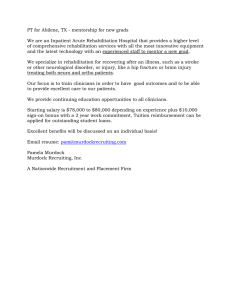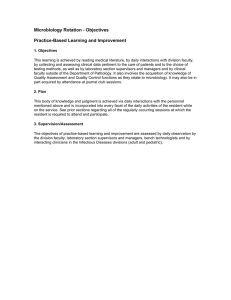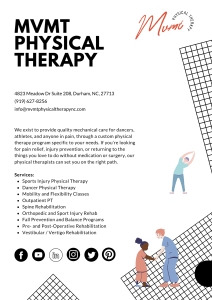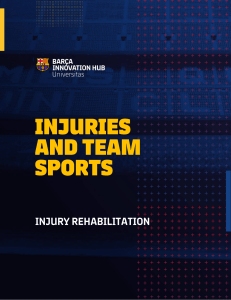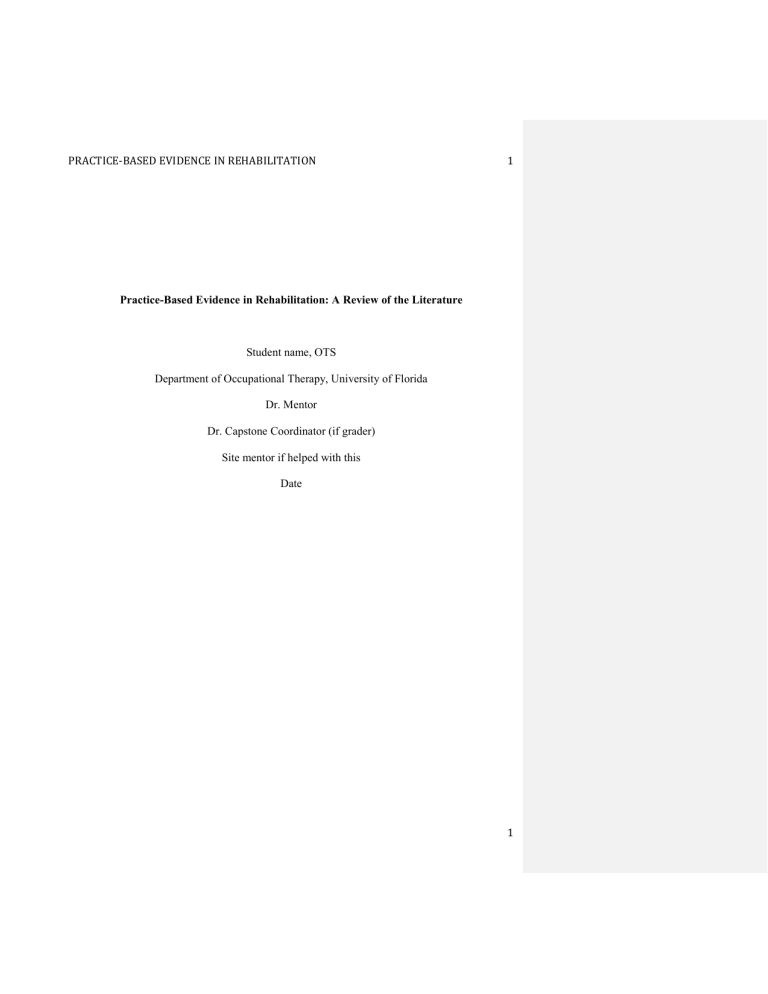
PRACTICE-BASED EVIDENCE IN REHABILITATION 1 Practice-Based Evidence in Rehabilitation: A Review of the Literature Student name, OTS Department of Occupational Therapy, University of Florida Dr. Mentor Dr. Capstone Coordinator (if grader) Site mentor if helped with this Date 1 PRACTICE-BASED EVIDENCE IN REHABILITATION 2 Practice-Based Evidence in Rehabilitation: A Review of the Literature The use of research in rehabilitation is a critical component of effective treatment for clients. Emerging healthcare professionals are taught the importance of integrating evidencebased practice when planning interventions for clients. Evidence-based medicine is defined as: "the conscientious, explicit, and judicious use of current best evidence in making decisions about the care of individual patients. The practice of evidence based medicine means integrating individual clinical expertise with the best available external clinical evidence from systematic research" (Sackett et. al, 1996). Randomized control trials are of the highest evidence of research and have a very important place in evidence-based practice. However, this type of research has limitations in that the populations of these studies are often very specific and generalizability is not always accurate or possible (Clay, 2010). Therefore, it is important to supplement our range of evidence with other types of research. Swisher (2010) states that practice-based evidence is where: “the real, messy, complicated world is not controlled. Instead, real world practice is documented and measured, just as it occurs, “warts” and all. It is the process of measurement and tracking that matters, not controlling how practice is delivered. This allows us to answer a different, but no less important, question than “does X cause Y?” (Missing citation) Practicebased evidence is also a way that clinicians can contribute to research. The purpose of this review is to explore how practice-based evidence can positively impact rehabilitation intervention outcomes for clients. Additionally, how this can encourage more participation of clinicians in research. Methods This literature review sought to answer the following question: how does the use of practice-based evidence impact intervention outcomes for adults receiving rehabilitation? Two 2 PRACTICE-BASED EVIDENCE IN REHABILITATION 3 databases were utilized in this review: PubMed and CINAHL. Figure 1 outlines the search Commented [SR1]: Reword in more active language methods and the process by which the articles were found and were narrowed down. The final search terms used in the databases were “practice based evidence” AND “rehabilitation” AND “outcomes”. Initially, the search yielded 59 total articles, combined, from the two databases. Commented [SR2]: Double check numbers here with figure After duplicate articles were removed, there were 37 articles remaining. The results were then refined using limiters, including: date published (last 10 years), subjects (adults), and language (English), which left 22 articles. Articles were excluded from this review if they were not related to physical rehabilitation (occupational therapy, physical therapy, or speech language pathology). With all exclusions considered, seven total studies were used for this review. Results Commented [KM3]: What were criteria for choosing the 7 articles and not the other potential? Seven articles were carefully chosen to be included for this literature review. From the articles, three themes were found that highlight the strengths of practice-based evidence that can lead to better outcomes for patients as well as availability of research for clinicians: generalizability of information, clinician participation, and extensive information leading to further research. Table 1 summarizes the articles found including the authors, purpose of the study, type of study, and a brief overview. There were a variety of types of studies that were Commented [KM4]: should include how many for each type included in this review, including: review of the literature, prospective observational study, and retrospective analysis. More information on the articles included can be found in table 1. Findings Generalizability of Information Many articles spoke on the benefits of practice-based evidence in that it is conducted in a natural setting without the strict controls constricting other types of research, such as randomized controlled trials. Kersten et. al (2010) states: “A key strength of the PBE methodology is that it 3 PRACTICE-BASED EVIDENCE IN REHABILITATION 4 includes the measurement of patients treated in routine practice, rather than in specially controlled circumstances, and the inclusion of virtually every patient contributes to a more naturalistic view.” Another article further highlights this idea, “The strength of the PBE methodology is its ability to examine a rehabilitation process occurring in a natural setting without extensive exclusion criteria and to identify the elements of that process that are related most strongly to positive outcome after rehabilitation” (Whiteneck et. al, 2010). This naturalistic design and inclusivity of patients allow for ease with application to practice for clinicians, “because of how PBE studies are conducted, their findings are readily translatable into practice” (Horn et. al, 2012). In a study by Christoforou et. al (2018), the researchers investigated the effectiveness of a community-implemented falls prevention referral service. Individuals who completed their program, Steady Steps, had improvements in outcome variables, such as: balance Commented [KM5]: colon use here is not APA confidence and quality of life. The authors wrote, “practice-based approach enabled us to better Commented [KM6]: need to add page and proper intext citation capture what is truly happening in practice at the point of referral…” Clinician Participation Another important strength of practice-based evidence is clinician participation. Because the studies are conducted in a naturalistic setting, it is critical to have the contributions from clinicians. This can allow for clinicians to trust the information found and they may be even more likely to use this information in their own practice. Horn et. al (2012) states, “Front-line clinicians often challenge the conventional wisdom and welcome the PBE approach as a method to test their ideas. Moreover, with clinicians fully participating in PBE studies, clinicians outside the study are more likely to address and, when appropriate, embrace counterintuitive findings.” Practice-based evidence often requires a team of individuals, “PBE study in rehabilitation is assembling a diverse project team with multiple areas of relevant expertise including 4 Commented [KM7]: this quotation is too long to be provided in-text; APA requires block quotations at this length – also need more adequate use of APA citation of quotations from published materials - PRACTICE-BASED EVIDENCE IN REHABILITATION 5 multidisciplinary rehabilitation care providers” (Horn et. al, 2012). Commented [KM8]: citation, page needed – this is true throughout Extensive Information Leading to Further Research Commented [KM9]: very long paragraph – needs to be broken up Because practice-based evidence is an observational type of study it often yields a lot of information. In one study, Whiteneck et. al (2013) used a practice-based evidence design to investigate spinal cord injury rehabilitation and discusses, in depth, the use of this methodology. This article reports that this was “…an observational study and that neither positive nor negative associations can be interpreted as reflecting a causal link without additional investigation.” However also states “The application of PBE methodology in the SCIRehab study provided Commented [KM10]: who also states? this is a sentence fragment extensive information about the process of inpatient SCI rehabilitation.” Although practice-based evidence cannot yield causation, it does yield a lot of information regarding interventions and outcomes. Additionally, many of the practice-based evidence articles discuss the idea that this type of methodology lends itself to further research that can be done, perhaps in a more controlled manner for a higher level of evidence. In an article by Siebens et. al (2016), the authors looked at variation in rehabilitation treatment patterns for hip fracture treated with arthroplasty. In this study, the researchers found a lot of varying information among the practice settings. In all of this information, the researchers stated, “This is among the first reports to present this level of detail on the content of therapy treatments for patients with hip fracture. The results include insightful observations that suggest hypotheses and questions for future work.” They go on to mention they would like to further investigate ideas such as: exposures to OT bathing and home programs, low volumes of intermediate and advanced ADLs, role of family contact, etc. Hammond et. al (2015) share that the results from their study on group therapy use on outcomes of inpatient rehabilitation after traumatic brain injuries was broad and more detailed and specific research should be conducted to get additional information on group therapy on 5 PRACTICE-BASED EVIDENCE IN REHABILITATION 6 overall outcomes. However, this article was able to get some helpful and abundant information regarding group therapy for TBI during inpatient rehabilitation due to the nature of the design of the study and was able to find that there is significant variation in this type of therapy across sites (10 inpatient rehab centers were utilized). Practice-based evidence often has a very large sample size and therefore is able to yield a plethora of helpful data, “PBE studies to date have involved very large number of patients (as in thousands)” (Kersten et. al, 2010). Conclusion In conclusion, the articles examined demonstrate that practice-based evidence can have a positive impact on outcomes in three ways: generalizability of information, clinician participation, and extensive information leading to further research. Because the studies have found that this type of research lends itself to greater generalizability, it can be easier for clinicians to successfully implement findings into their own practice. The studies include many participants in a naturalistic setting that may allow clinicians to feel more confident in applying the findings in their intervention planning. This in itself increases research being utilized in practice and can lend to better outcomes for patients. Clinician participation in research is critical so that practicing clinicians seeking articles are able to know what interventions are currently actually being done in the field and if they work or not. Increased participation by clinicians in research not only increases the quality of care given to patients, but can also increase confidence in clinicians as they do their own searches of the literature. Clinicians may be more inclined to take from studies that are done heavily by practicing clinicians. Lastly, the extensive amount of information that can come from practice-based evidence is crucial. Not only is it information that clinicians can use (even if it doesn’t merit causation), it lends itself to even more research that can be done. Getting the initial information/data through practice-based evidence, can allow for 6 Commented [KM11]: I’m not sure they demonstrate, perhaps: indicate, suggest, provide evidence as to the potential for PRACTICE-BASED EVIDENCE IN REHABILITATION 7 more focused and helpful studies to be completed in a more controlled manner. One limitation from this review is that, although seven articles were included, some of them had overlapping studies and authorship due to the limited amount of research in this area. Commented [SR12]: Use third person or neural “the information form this ….. I will use the information from this study as a helpful guide in promoting increased participation of clinicians in research. This information highlights the importance of practicebased evidence in rehabilitation. I will further investigate the methodology in hopes of breaking it down more to create a guide on how clinicians can be contributing to this type of research in a larger way. My presentation will focus on how clinicians can be contributing to research so that we can expand practice-based evidence in the field of occupational therapy. 7 PRACTICE-BASED EVIDENCE IN REHABILITATION 8 References Christoforou, A., Van der Linden, M. L., & Koufaki, P. (2018). Short-term effectiveness of a community-implemented falls prevention referral service. Disability and rehabilitation, 40(20), 2466–2474. https://doi.org/10.1080/09638288.2017.1337241 Clay, R. (2010, September). More than one way to measure. Retrieved April 04, 2021, from https://www.apa.org/monitor/2010/09/trials Hammond, F. M., Barrett, R., Dijkers, M. P., Zanca, J. M., Horn, S. D., Smout, R. J., Guerrier, T., Hauser, E., & Dunning, M. R. (2015). Group Therapy Use and Its Impact on the Outcomes of Inpatient Rehabilitation After Traumatic Brain Injury: Data From Traumatic Brain Injury-Practice Based Evidence Project. Archives of physical medicine and rehabilitation, 96( 8 Suppl), S282–92.e5. https://doi.org/10.1016/j.apmr.2014.11.029 Horn, S. D., DeJong, G., & Deutscher, D. (2012). Practice-based evidence research in rehabilitation: an alternative to randomized controlled trials and traditional observational studies. Archives of physical medicine and rehabilitation, 93(8 Suppl), S127–S137. https://doi.org/10.1016/j.apmr.2011.10.031 Kersten, P., Ellis-Hill, C., McPherson, K. M., & Harrington, R. (2010). Beyond the RCT understanding the relationship between interventions, individuals and outcome - the example of neurological rehabilitation. Disability and rehabilitation, 32(12), 1028–1034. https://doi.org/10.3109/09638281003775568 Sackett, D. L., Rosenberg, W. M., Gray, J. A., Haynes, R. B., & Richardson, W. S. (1996). Evidence based medicine: what it is and what it isn’t. BMJ : British Medical Journal, 312(7023), 71–72. 8 PRACTICE-BASED EVIDENCE IN REHABILITATION 9 Siebens, H. C., Sharkey, P., Aronow, H. U., Deutscher, D., Roberts, P., Munin, M. C., Radnay, C. S., & Horn, S. D. (2016). Variation in Rehabilitation Treatment Patterns for Hip Fracture Treated With Arthroplasty. PM & R : the journal of injury, function, and rehabilitation, 8(3), 191–207. Swisher A. K. (2010). Practice-based evidence. Cardiopulmonary physical therapy journal, 21(2), 4. Whiteneck, G., & Gassaway, J. (2010). SCIRehab: a model for rehabilitation research using comprehensive person, process and outcome data. Disability and rehabilitation, 32(12), 1035–1042. https://doi.org/10.3109/09638281003775584 Whiteneck, G. G., & Gassaway, J. (2013). SCIRehab uses practice-based evidence methodology to associate patient and treatment characteristics with outcomes. Archives of physical medicine and rehabilitation, 94(4 Suppl), S67–S74. https://doi.org/10.1016/j.apmr.2012.12.022 9 10 PRACTICE-BASED EVIDENCE IN REHABILITATION Appendix Figure 1. Identification PRISMA Diagram Records identified through database searching (n = 30 ) Additional records identified through other sources (n = 29) Included Eligibility Screening Records after duplicates removed (n = 37 ) Records screened (n = 37 ) Records excluded (n = 15 ) Full-text articles assessed for eligibility (n =22) Full-text articles excluded, with reasons (n = 14 ) Studies included (n = 7) From: Moher D, Liberati A, Tetzlaff J, Altman DG, The PRISMA Group (2009). Preferred Reporting Items for Systematic Reviews and Meta-Analyses: The PRISMA Statement. PLoS Med 6(7): e1000097. doi:10.1371/journal.pmed1000097 For more information, visit www.prisma-statement.org. Commented [SR13]: Make your own figure as might not have permission to use this, this is not the correct APA format for Figure 10 11 PRACTICE-BASED EVIDENCE IN REHABILITATION Table 1. Literature Review Matrix Author Title Purpose Paula Kersten, et. al, 2010 "explore such issues Beyond the RCT including the complexity understanding the of rehabilitation relationship between interventions, interventions, heterogeneity of individuals and populations, selective outcome - the research samples and example of multiple understandings neurological and perspectives of rehabilitation benefits" Susan D. Horn, et. al, 2012 Practice-Based Evidence Research in Rehabilitation: An Alternative to Randomized Controlled Trials and Traditional Observational Studies Type of study Critical review of the literature "give examples of how PBE designs have been used in various rehabilitation areas to determine better treatments for Review of the specific types of patients." literature Comments/outcomes/implications This study discusses the use of randomized control trials versus alternative types of studies (i.e. practice based evidence (PBE), qualitative studies, etc.). It found that we should be aiming for a variety of different types of research and include more practice-based evidence/qualitative studies to allow for increased carryover of knowledge for clinicians. This study compares randomized control trials, observational claims data, and practice based evidence studies. It defines practice based evidence as: "PBE methods address comparative effectiveness of treatments by creating a comprehensive set of patient, treatment, and outcome variables and analyzing them to identify treatments that are associated with better outcomes for specific types of patients." It also highlights the idea that practice-based evidence relies on the knowledge of clinicians and on their experiences. "PBE methods work best in situations where one wishes to study existing clinical practice." This study states that PBE can be a great addition to our current body of research, especially with regard to clinical decision-making. 11 12 PRACTICE-BASED EVIDENCE IN REHABILITATION Gale G Whiteneck, et. al, 2013 SCIRehab Uses Practice-Based Evidence Methodology to Associate Patient and Treatment Characteristics With Outcomes Gale Whiteneck, et. al, 2010 SCIRehab: a model for rehabilitation research using comprehensive person, process and outcome data "To describe the application of practicebased evidence (PBE) methodology to spinal cord injury (SCI) rehabilitation in the SCIRehab study, and to summarize associations of patient characteristics and treatment interventions to outcomes" "This article aims to present a comprehensive conceptual model of the SCIRehab project, which merges the International Classification of Functioning, Disability, and Health (ICF) focus on outcomes with the practice-based evidence (PBE) research design, which focuses on process and also quantifies person and outcomes details." Short-term effectiveness of a communityimplemented falls prevention referral service "To evaluate the effectiveness of the 16week evidence-based Steady Steps exercise referral scheme at improving physical function, balance confidence, and quality of Andrea Christoforou, et. al, 2018 Prospective observational study This article looks at PBE in the scope of SCI rehabilitation. This study states that PBE in the case of SCI has been able to add to the scope of practice/evidence immensely. This is particularly related to inpatient rehabilitation. "The PBE methodology has 2 basic strategies to control for differences in patient needs. The first approach is to statistically control for patient demo- graphic and injury characteristics by including those variables in regression analyses before entering treatment variables. The second approach is to analyze subgroups of patients with common injury characteristics and thus, common treatment needs." prospective observational study This study looks at the strength of using PBE with regard to the SCI population. It states that "PBE acquires that ability by collecting very detailed person, process and outcome data on large numbers of cases." It describes the need for PBE as a means to complement RCT, not replace them. A nonexperimental, practice-based study involving a retrospective analysis of participant outcomes. This study utilized a practice-based methodology, testing effectiveness of a community-implemented falls prevention referral service. The results showed clinically meaningful improvements observed in individuals who completed the evidence- based Steady Steps program. Although the authors provide disclaimers that this study uses a non-experimental design, it gives hope that practice-based evidence can be very useful for clinical decision making. 12 13 PRACTICE-BASED EVIDENCE IN REHABILITATION life (QoL) of communitydwelling older adults at risk of falling." Hilary C. Siebens, et. al, 2016 Flora M.Hammond, et. al, 2015 Variation in Rehabilitation Treatment Patterns for Hip Fracture Treated With Arthroplasty. Group Therapy Use and Its Impact on the Outcomes of Inpatient Rehabilitation After Traumatic Brain Injury: Data From Traumatic Brain Injury–Practice Based Evidence Project "To document in detail the physical and occupational therapy treatment activities for inpatient hip fracture rehabilitation among 3 patient subgroups distinguished by their early rate of functional recovery between time of surgery to rehabilitation admission." "To describe the amount and content of group therapies provided during inpatient rehabilitation for traumatic brain injury (TBI), and to assess the relations of group therapy with patient, injury, and treatment factors and outcomes" Multicenter prospective observational cohort, practicebased evidence, study This study looks at the variation of treatment for hip fractures with arthroplasty utilizing practice-based evidence approach. This study yielded variations in OT/PT treatment patterns for this population. This was a very powerful study as it "is the first PBE-CPI rehabilitation study in which all PT and OT treatment activities are reported in a single table. This facilitates thinking about an individual patient’s care by both disciplines." This is a very interesting article in that it allows us to look at both PT and OT outcomes within the practice-based evidence realm. This type of research is critical for clinicians to learn and understand best practice. Prospective observational cohort This study utilizes an evidence based practice framework to look at group therapy for TBI patients in inpatient rehab. This study showed quite a bit of variety in outcomes when comparing differences in treatment at inpatient rehab facilities. I think this is an important finding in the context of utilizing practice based evidence in that it shows that it is critical to know what is going on at different facilities and how this is benefiting patients in the real world. 13
